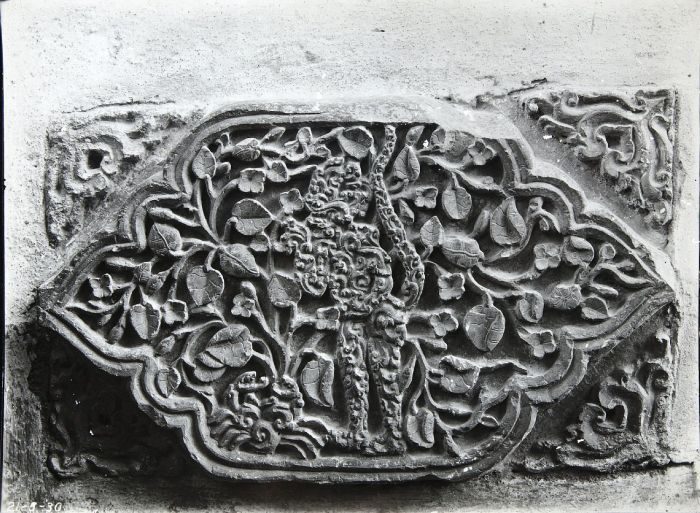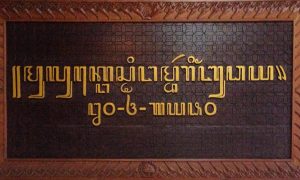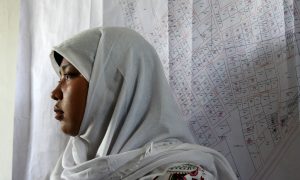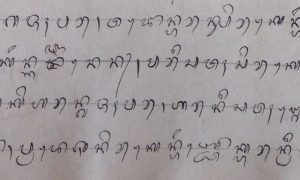The history of Java has no shortage of powerful women rulers, from the 14th-century queen Dyah Gitarja, whose imperial conquests can be role-played in the strategy game Civilization VI, to Megawati Soekarnoputri, former president and leader of the largest faction in the current Indonesian parliament.
This prominence is part of a historical pattern where Southeast Asian women, especially of royal and aristocratic birth, have held significant authority and autonomy in comparison to women in East and South Asia. Barbara Watson Andaya’s 2006 monograph The Flaming Womb provides a detailed study of the construction of gender and the status of women in early modern Southeast Asia.
This is a short biography of a Javanese woman of the 16th century called Ratu Kali Nyamat (The Queen of Nyamat River). She emerged out of a war of succession over Java’s first great Muslim empire to become the queen of the prosperous city-state of Jepara. Governing in her own right during the third quarter of the century, she was a key ally of the king of central Java, Hadi Wijaya.
Kali Nyamat was one of the earliest anti-colonial fighters in the archipelago, launching many warships against the Portuguese base at Malacca. Under her leadership, Jepara engaged in strategic alliances with the rulers of Johor (Malay peninsula), Aceh (Sumatra), Banten and Cirebon (West Java) and Hitu (Ambon).
She also patronised Islamic religion and culture in her kingdom, including the exceptional Mantingan mosque. Today, Jepara’s citizens celebrate her achievements in the town’s annual birthday parade.

A cosplayer acts as Queen Kali Nyamat for Jepara’s anniversary (Photo: Ikon Jepara 2016).
A quick note about some historiographical issues. The 16th century is one of the most difficult periods of Javanese history to study, because we are almost entirely lacking in local primary sources from that time. We therefore have to rely on a combination of 16th-century Portuguese sources and later Javanese sources to reconstruct the broad outlines of Kali Nyamat’s career.
The following recount mostly follows the work of H.J. de Graaf and Th. Pigeaud, whose studies of the early Muslim kingdoms in Java (published in 1974 and 1976) are still authoritative.
Kali Nyamat’s Origins
Like many women leaders in the region, Kali Nyamat was born into royalty. The Javanese sources agree that she was the daughter of Trenggana, the ambitious ruler of Demak (reigned 1521–1546) who turned that city into the capital of an empire stretching across the whole north coast of Java and over the sea to include parts of southern Sumatra. The Javanese text Babad ing Sangkala (compiled in 1738) records a near-continuous series of battles across Java throughout the 1520s, 1530s and 1540s, which can be attributed to Trenggana’s expansionist campaigns.

The extent of Trenggana’s empire, with its capital at Demak. From Robert Cribb, Digital Atlas of Indonesian History (Copenhagen: NIAS Press, 2010), reproduced with permission.
During her father’s reign, Kali Nyamat had married a merchant-politician whose origins are uncertain: some Javanese accounts claim he was a Muslim Chinese immigrant, while others state he was a member of the Acehnese royal family. Having settled in Java, he became a vassal of Trenggana and set up his noble house at Kali Nyamat, not far south of the harbour of Jepara.
This harbour was a key economic asset that allowed Trenggana to control the link between the agricultural surplus of Java’s interior and the rich commercial markets of the archipelago. Trenggana’s daughter and her husband became known as the “Queen and Prince of Kali Nyamat”.
Tragedy and Triumph
The events immediately following Trenggana’s death in 1546 are known from 18th- and 19th-century Javanese traditions, as well as from a handful of 16th-century Portuguese reports.
The sources agree that Trenggana’s conquest state began to disintegrate when he died, leaving behind many contenders for supreme power in central Java. One of these, Kali Nyamat’s brother Sunan Prawata, seems to have been on the throne between 1546 and 1549. After this three years, he was killed by a rival who, in some sources, is called Arya Penangsang. Kali Nyamat protested, and so to marginalise her, Arya Penangsang killed her husband as well. Anguished by the murders of her brother and husband, Kali Nyamat retreated into the highlands of Mount Dana Raja, where she began to perform austerities and concentrate her spiritual power.
A third contender for supremacy, Hadi Wijaya, visited Kali Nyamat on the mountain. She convinced him to move against Arya Penangsang and promised a political alliance if they were victorious. In the end, there was a pitched battle in which Arya Penangsang was killed. Kali Nyamat returned to her palace to take control of Jepara as its queen.
Kali Nyamat in Power
In 1559, the Queen built a beautiful mosque and cemetery at Mantingan in memory of her husband. The photographs below (taken in 1930 and belonging to the collection of the Archaeological Service) show the carved reliefs in the Mantingan mosque, believed to reflect the Islamic artistic styles of Jepara under Kali Nyamat’s rule.
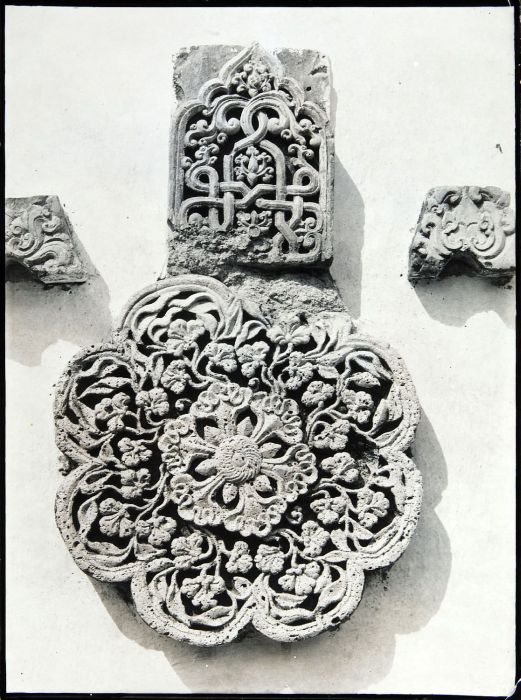
Archival photo (TM-60054167) of floral ornamentation that was part of the original structure of the Mantingan mosque (Photo: Tropenmuseum)
Although the central Javanese traditions claim that Kali Nyamat was a vassal of Hadi Wijaya, the other sources make it clear that she was a sovereign ruler in her own right.
Since Hadi Wijaya’s power was based in the interior rice-bowl region of Pajang, it is quite possible that his strategic partnership with Kali Nyamat extended to trade: while his inland kingdom produced agricultural goods, her coastal territory connected those goods to overseas markets.
Jepara now became the single major port of central Java, while Demak’s commercial importance dwindled. The Portuguese noted with concern how wealthy Jepara was becoming under Kali Nyamat’s rule, as she developed her city as a trading hub in direct competition to European-controlled Malacca.
Fighting the Portuguese
Competing with the Portuguese meant naval warfare, often in the name of religion. The rhetoric of Islamic holy war was an effective means for the rulers of Jepara, Aceh, and Johor to build military alliances against the Catholic Portuguese.
Kali Nyamat is recorded as having sent two naval attacks against Malacca. The first, in 1551, was a response to a call for help by the sultan of Johor, who wished to reclaim the city that his father had once ruled. Kali Nyamat supplied 40 warships and 4000 troops to the Muslim alliance that nearly succeeded in capturing the whole city, before being beaten back at the last minute by the Portuguese defenders.
The second, a three-month siege of Malacca in 1574, seems to have been a solo effort by Jepara that was not well coordinated with Acehnese military action around the same time. As a result, the Portuguese were able to resist these attacks as well.

Portuguese sketch of an Acehnese attack on Malacca (Photo Source)
Kali Nyamat also intervened in the eastern part of the archipelago, such as on the island of Ambon. The Portuguese, who were trying to build a trading post there, were dismayed that resistance by the local Hitu Confederation was being actively supported by Jepara. Memories of cooperation between the Hitu and the Javanese are also preserved in the Malay text Hikayat Tanah Hitu (composed around 1662).
The period of Kali Nyamat’s rule, which ended at her death sometime after 1574, was without doubt the high point of Jepara’s political and economic influence in the region.
Kali Nyamat in History
The energetic career of Queen Kali Nyamat reveals some important facts about gender, religion, and power in this period of Southeast Asian history.
First, it shows that orthodox Muslim states did not forbid royal women from ruling in their own right. Indeed, women were among the most effective leaders of the period. Aceh’s succession of four queens between 1641 and 1699 is another good example of this.
Second, it shows how military opposition to the Portuguese was based on the common self-interest of the Muslim trading states. Javanese, Malays, Ambonese, and Chinese worked together to try to expel the Portuguese, in order to regain Muslim control of the lucrative inter-island trading network. The rhetoric of religious and national liberation, which was so important to 19th- and 20th-century anti-colonialism, was largely absent from these 16th-century conflicts.
Women leaders of the premodern period are beginning to receive greater recognition within Indonesia. On National Heroes Day in November 2017, the President appointed the Acehnese admiral Keumalahayati (who was active around 1600) as a National Hero for her efforts to resist colonialism. There is a strong case for Queen Kali Nyamat to receive similar recognition, despite some official reluctance to grant her this honour, for building a wealthy and influential coastal state that contributed significantly to the anti-colonial struggle of the late 16th century.
 Facebook
Facebook  Twitter
Twitter  Soundcloud
Soundcloud  Youtube
Youtube  Rss
Rss 